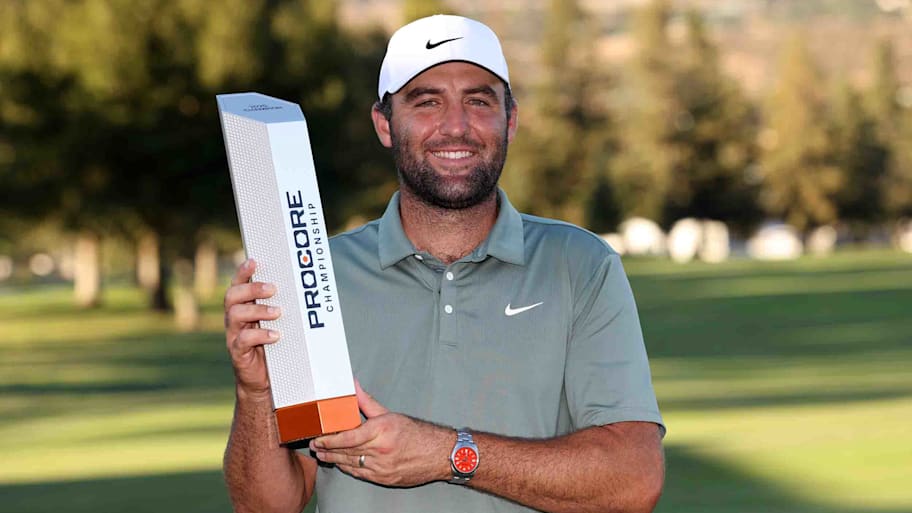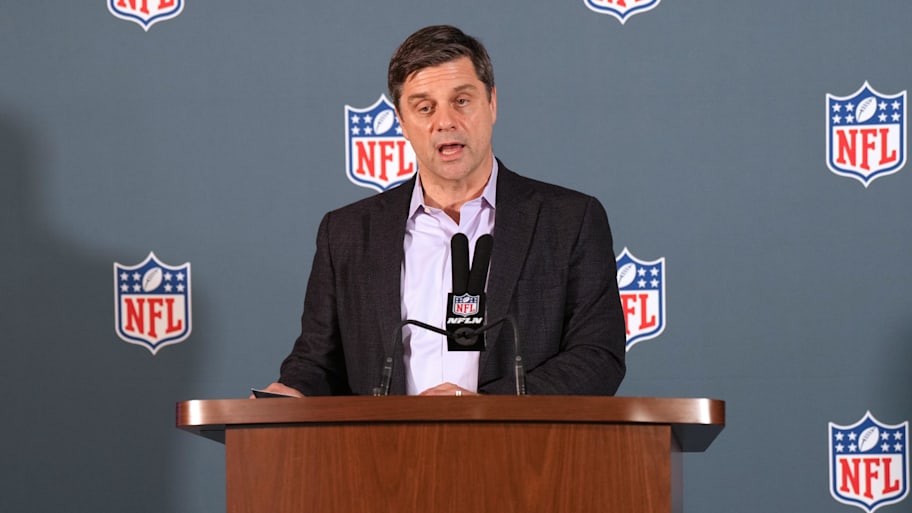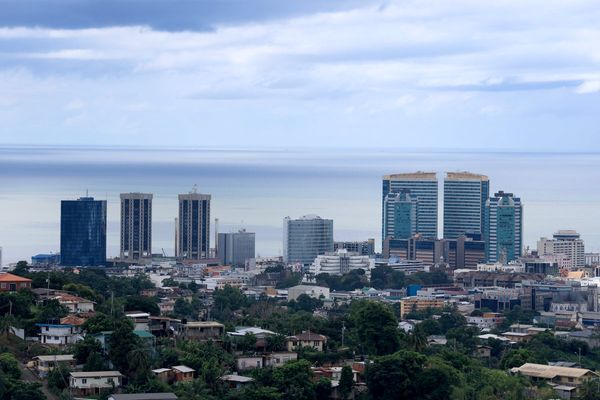
Lanto Griffin was holding back tears.
After being plagued by injuries in the past few years, the 37-year-old was fighting to finish inside the top 100 in FedEx Cup standings to earn full PGA Tour status for 2026. Entering September’s Procore Championship, the first of seven FedEx Cup Fall events, he was ranked No. 142 in points. Then, he finished T3 for his best result since 2022, moving him to No. 109.
Afterward, in the middle of an emotional post-round interview with Golf Channel, Griffin snuck a seven-word admission—tongue-in-cheekly—into one of his responses.
“I kind of wish Scottie wasn’t here,” he said.
That’s because world No. 1 Scottie Scheffler won the tournament, finishing two strokes ahead of Griffin for his sixth title of the year. Of course Scheffler, nor runner-up Ben Griffin, didn’t need to play that week. They were using it as preparation for the Ryder Cup later that month.
Therefore, had they not teed it up, Lanto Griffin may have won and secured a two-year exemption.
Griffin, however, has insisted that the comment wasn’t serious, although it wasn’t completely devoid of earnestness.
“Yeah, truth only because [Scheffler] beat me and obviously it’s the two Ryder Cup guys,” Griffin recently told Sports Illustrated. “Not that I would have won if they weren’t there, because it would have been a completely different situation.
“But it was a total joke. Obviously, if he wasn’t there, I would have locked my card up, but yeah, that was my little dry sarcasm that some people took out of context.”
It begs the question, though: What should the FedEx Cup Fall be?
Three years ago, the Tour moved away from its wraparound seasons, which began in September and ended with the Tour Championship in August. Instead, the seven-event fall schedule is now a chance for players outside the top 70 to secure their status for the following season by finishing inside the top 100 threshold, or claim conditional status by being top 125, at the end of the year. Those between Nos. 51 and 70 are safe, but their objective in the fall is to earn entry into the ensuing season’s first two signature events, which boast $20 million purses, most without a cut.
That adds a whole other element to the fall series.
“We always try to put the positive spin on our event,” said Davis Love III, the host of the annual fall finale, the RSM Classic. “So yes, those stories make it fun. Something more than just 156 guys playing to win the RSM Classic. There’s a whole bunch of other stories. And the Tour does a great job of saying, ‘look, here’s your storylines that are going to happen this week.’ There’s a lot going on.”
Still, the sport’s biggest names, like Scheffler, are free to play whenever, wherever they want. With that privilege, they often make a start or two in the fall (unless they finish the year on the DP World Tour). In doing so, Scheffler, Xander Schauffele and Ben Griffin have each won this fall, complementing three other first-time winners.
And those fighting for status next year aren’t necessarily opposed to that.
“If Scottie played every event this fall, I’d have no issue with it at all,” Lanto Griffin said. “... That [T3] actually made my week feel more accomplished, that made me feel better than finishing third in an event with nobody in the top 50, so there’s a lot of ways to look at it.”
But the fall series might be getting a facelift.
The new CEO’s vision
When Brian Rolapp began his new role as PGA Tour CEO earlier this year, he preached three themes to achieve his goal of a “holistic relook” for the circuit: Parity, simplicity and scarcity.
“How do you actually drive a competitive schedule where every event matters, that is connected to a postseason?” he asked.
Golf is essentially year-round. Just a few weeks after the season-ending Tour Championship in August, the fall schedule begins, running off and on until mid-November. After that? The silly season, leading into the start of the regular season in January.
One of the key purposes of scarcity is for fans to miss golf the way they miss the NFL in the offseason (Rolapp was previously the NFL’s chief media and business officer).

To be fair, the mission of the fall series changed in 2023. With the wraparound season gone and the inception of signature events, the quiet part is being said out loud: the Procore Championship, for example, doesn’t boast the same significance as the Genesis Invitational or even the non-signature Cognizant Classic. But three years ago, every tournament was on equal footing (or at least it was advertised that way), aside from the purse sizes.
The signature events, though, have limited-sized fields. And with nine of them next season, plus regular tournament field sizes being reduced, there are fewer opportunities for lower-tier players to get starts, compared to a few years ago.
“It’s crucial for the rookies and for the everyday players to have this opportunity [in the fall] because when you look at the regular season, there’s a lot of long breaks in the middle of the year with the signature events,” Golf Channel analyst and three-time PGA Tour winner Johnson Wagner told Sports Illustrated, “and so if you’re not in those, you, you need to have the opportunity to get on a run like so many players have done this fall to keep your job.”
But fall golf isn’t going away. The Tour has announced two new autumn tournaments for 2026, the Biltmore Championship in Asheville, N.C., and the Good Good Championship in Austin, with sponsors signing on for four-year deals. There’s a chance those will replace the Procore and Sanderson Farms championships on the schedule, with those sponsorship agreements having expired this year.
“I kind of was concerned that the PGA Tour was starting to phase the fall out altogether,” Wagner says, “and the fact that two new events have been added … it’s a good thing going forward. I think it’s easing a lot of people’s fears that the tour is trying to phase the fall out.”
Because even though they don’t boast the same prestige as a signature event, later-year tournaments can be special for many people.
“Tournaments like this, I don’t want to see them go away because I know how much they mean to this community," Harris English said at the RSM Classic. “A lot of these fall events, we go to a lot of places in the country that they don’t get a whole lot of golf tournaments, and you can tap into a different fan base. I don’t really want to see them go away, but I think they’ll find a time and a place for some of those.”
So what tweaks could perhaps be made post-Tour Championship?
“Obviously, it’s a pretty loaded question,” Griffin says. “There’s not necessarily a clear and concise right or wrong answer.”
Ch-ch-ch-changes?
Wagner believes a good starting point would be to compact the schedule.
“It would be nice to sort of condense it down and maybe not play all the way up until Thanksgiving,” the 45-year-old said.
Also, potentially moving away from the Thursday through Sunday format.
“Going up against football all fall, I mean, you don’t have the top players,” Wagner says, “I would like to see sort of a Tuesday, Wednesday, Thursday, Friday model in the fall. I think that would be interesting.”
And with Rolapp, there will be a common denominator driving his decision-making.
“As I said in my old job and I’ll say it in this job,” he said, “I didn’t cheer for teams, I cheered for television ratings.”
So that probably means the FedEx Cup Fall won’t turn into a glorified Q-school.
The final round of the Procore Championship, which included 10 of 12 members of the U.S. Ryder Cup team, averaged 441,000 viewers on Golf Channel (fall events aren’t broadcast on network channels like CBS or NBC). Sure, it wasn’t a ratings bonanza, but it was a 400% increase from 2024.
Judging from that, the banishment of stars playing won’t happen—not that it would be welcomed if it did.
“Bottom line, this is still a PGA Tour event and every PGA Tour event that I play is an honor and I don’t take it for granted,” Sahith Theegala said at November’s Butterfield Bermuda Championship. “A lot of people ask me why I’m here this week because I’m exempt next year and don’t need to try to get in the top hundred or anything like that.
“Again, it’s just a place that I have a lot of good memories of. I feel like my game is starting to get in a good place, just wanted to get more competitive reps.”
And just because exempt players want to tee it up doesn’t mean they’re hindering others from trying to obtain playing privileges for the following season.
“My comment in Napa was simply because I finished third and [Scheffler] finished first,” Griffin says. “If I had finished 50th, Scottie finishing first would have helped me.”
How so? Griffin sees it like this: When Steven Fisk won the Sanderson Farms Championship (the second fall event), he moved from No. 135 in FedEx Cup points (behind Griffin) to No. 65. Had Scheffler played that week and won, Griffin would have moved at least one spot closer to the 100 number. Plus, the stronger strength of field, the more world ranking points at stake.
“It’s a messed-up way of looking at it, and we don’t think about it that way,” says Griffin, who is 123rd in points entering the RSM Classic, “but I guess the point I’m trying to get is that if J.J. Spaun’s gonna play [the World Wide Technology Championship] … I told [his caddie], ‘I want you to play well, just don’t beat me.’ So if I finish second, you finish third, now you didn’t take points from me, but you took them from everybody else behind me.”
Maybe there comes a day when the big names make more than one or two PGA Tour stars after the Tour Championship. Rory McIlroy, for example, has made five starts on the European circuit. Could the PGA Tour, which has a strategic alliance with the DP World Tour, get a piece of the pie in the DPWT’s season-long Race to Dubai? Would the American players be up for that after nine grueling months of golf? That would certainly help Rolapp’s goal of maximizing interest, but at what cost?
"Did you think this moment would come?"
— PGA TOUR (@PGATOUR) November 16, 2025
"No, I really didn't."@ACSchenk1 is a PGA TOUR champion @Bermuda_Champ 🏆 pic.twitter.com/YqtFF4VM0u
For now, something similar to the current format will likely remain in place for the foreseeable future, as the current television contracts run through 2030.
“Give Brian a couple of years to really learn the system, find what’s the best avenue for us to grow,” Griffin says.
Of course, the fall series, going head-to-head with the NFL, college football and Major League Baseball’s postseason, will never blossom into the PGA Tour of spring and summer.
But there’s one thing the fall isn’t lacking: meaning.
Adam Schenk came into the Bermuda Championship No. 134 in points, with his future on Tour uncertain beyond 2025. However, the 33-year-old, despite 15 missed cuts in 27 starts this year, withstood whipping conditions, sometimes putting one-handed, and buried a 4-footer on the last for a one-stroke, maiden Tour victory.
Moments after, like Griffin a few weeks earlier, he was fighting back tears.
“That was just a massive putt for me to make, a massive putt to have go in,” Schenk said. “It’s somewhat life-changing. It’s life-changing I get two more years on the PGA Tour.”
More Golf from Sports Illustrated
This article was originally published on www.si.com as The Conundrum of What the PGA Tour’s FedEx Cup Fall Is and What It Should Be.







